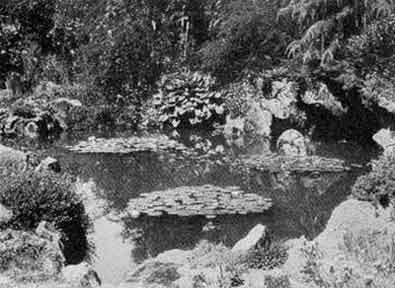By ROMAINE B. WARE
Page 1 [1] | Page 2 | Page 3 [2] | Page 4 [3]
Full sunlight is desirable if lilies are to bloom properly. They will grow in partial shade but bloom only sparsely. For formality, the location should generally be upon the principal axis of the garden and demands no particular background, but an informal treatment does not demand such care, and is more effective with a background.
In the average back yard garden, an informal, naturalistic pool seems to be most popular today. To build and plant such a pool calls for an understanding of Nature that is obtainable only from actual study in the great outdoors. The more you observe Nature's way of planting around lakes and ponds and her schemes of rock formation, the better you will be able to build, plant and arrange. Constant study of the subject pays dividends.

WHERE THE FAIRIES LIVE
Let us count the cost of pool building. Sand, gravel, and cement are the necessary ingredients for the pool proper, and at present prices enough for a pool ten by fifteen and two feet deep should be no more than twenty-five dollars. Many practical gardeners will be able to do the actual labor themselves with the aid of one man, hired on a day basis. Excavating for the pool is a simple task and most practical gardeners are quite familiar with the mixing of concrete. The gardener planning to build a pool will do well to obtain a copy of the recent book, Garden Pools, Large and Small, by L. W. Ramsey and C. H. Lawrence, Macmillan, 1931, published at $2.50.
Pools must have sub-drainage, to prevent heaving by frost; the concrete must be properly reinforced and requires waterproofing to make a good job. None of these things are difficult but they cannot be neglected.
When the cement work is complete the next task is margin planting, and here skill in use of materials can make or mar your pool. Much of its success will depend upon how natural it looks. The Nature student who has carefully observed streams, ponds and rock formations in the wilds will here find good use for his knowledge. The more skillfully you blend the pool with its location and surroundings the better your job will appear. Margin plantings, rocks or soil should completely conceal the edge of the concrete. The rocks must be placed naturally; do not stand a great many stone slabs upon edge around the pool; lay them in strata as Nature places them. Boulders are more difficult to place, as the tendency is to expose too much of them to view. Rocks 'around a pool should never be placed for display; rather they should nestle in among the plants and project only a little from the soil.
Among the many charms of a garden pool not the least are the aquatic plants, such as waterlilies. The graceful cat-tail, water hyacinth, umbrella plant and others may be used even in a small pool, though care must be exercised to avoid spoiling the play of light and shadow upon the surface of the water, which is one of the chief features of the pool. Most of the aquatics, however, are easily kept within bounds simply by cutting off or pulling out a portion of their foliage or in some cases cutting away a part of the root mass. With waterlilies this is important as they grow vigorously and the leaves crowd upon each other.
Many low growing perennials and rock plants are admirable under such conditions. What you plant is largely a matter of taste and the effect will depend upon how naturally you blend your materials and how carefully you select the species. For example, flowers such as calendulas, asters or petunias would be quite out of place, whereas forget-me-nots, arabis, or similar things will fit in nicely. At some points along the margin, the lawn may extend to the water's edge. At others, there may be a bank of rocks and at still other points a miniature gravel beach. All these features are natural.
